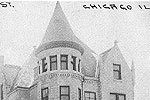|

South Lakefront
(continued)
Cornell's next move was to establish a firm economic base for
Hyde Park. Having seen the first push by the middle class out
of the center of the city, he took advantage of this demographic
movement. Cornell was aware of his competition, such as Stephen
Douglas's enterprise just north of Hyde Park, which had attracted
the first University of Chicago and
provided the Douglas area with an apparently stable anchor (See
Fig. 1).
Paul Cornell was related by marriage to John Evans, after whom
Evanston had been named, and to Orrington Lunt, another Evanston
father and founder of Northwestern University. He was also familiar
with Evanston's success, and this influenced his idea of what
Hyde Park should be. As Jean Block has pointed out in her book,
Hyde Park Houses, Cornell wanted an institution like Northwestern
University to be the economic and cultural base of his settlement.
He set aside land along the lakefront south of 53rd Street as
a site for a Presbyterian theological seminary. His plans, however,
were not successful, and Hyde Park remained without an institutional
base until the 1890s.
Despite this setback, the settlement continued to grow. Many
of those who invested in Hyde Park early on were related to Cornell
and kept up their support. The Illinois Central railroad connection
with Chicago was of utmost importance, and lots that were for
sale were generous in size. Thus those who were attracted to Hyde
Park were precisely of the class and character that Cornell wanted.
«
previous
5
of 23
next
»
|
 |

|
 |


Figure 1:
Fraternity house, 923 E. 60th Street, c. 1913.
»
|